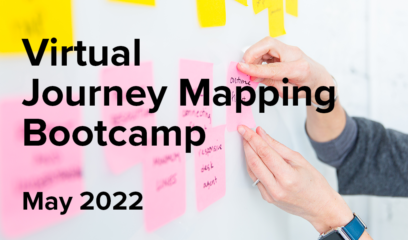A few weeks ago, I presented a webinar called “10 Ways To Use Customer Journey Maps” as a part of Qualtrics’ CX Week. (You can download the slides here. Or watch the webinar—just register for free at CXWeek.com and look for my webinar on the Wednesday agenda.)
During the webinar, I received a ton of great questions about how to create and use journey maps. In fact, I got so many questions that I ran out of time to answer them all! So I’m writing up the answers in a three-part series.
Are there any consistent elements in all journey maps?
In my webinar, I mentioned four main types of journey maps: current state, future state, day in the life, and blueprint. Each type is a little bit different—and honestly, even within a single type, no two journey maps are exactly alike. But I’ve found that effective journey maps:
- Indicate WHO is going through the journey. An 18-year-old opening a bank account is likely to have a very different experience than a 63-year-old completing the exact same task. So first and foremost, define your persona—or at the very least, your target customer segment.
- Focus on a particular customer task or goal. Some journey maps might try to depict the entire customer lifecycle, but these are often just inside-out marketing documents in disguise. Ask yourself: What would our customers tell us they’re trying to do? Then map that.
- Illustrate the steps that customers take on a timeline. In 99% of the journey maps I’ve seen, that timeline is represented on a horizontal axis.
- Show customers’ thoughts, emotions, and perceptions throughout the journey. Many journey maps accomplish this through emoticons and customer quotes. Some also have lines that undulate up and down across the timeline—up means “good” or “positive” emotions and down means “bad” or “negative.” How else can you represent these concepts? You’re limited only by your imagination!
- Highlight the customers’ biggest pain points or the biggest opportunities for improving the journey. Again, there are multiple ways to accomplish this from a visual design perspective.
- Are discernable at a glance. Every company’s got a million slide decks and spreadsheets chock-full of customer data, but it can take serious cognitive effort (and statistical analysis chops) to distill any insights from these documents. In contrast, the most effective journey maps I’ve seen make the key details pop so that insights are immediately digestible and actionable.
How granular should a journey map get?
That completely depends on your business objective. If you’re trying to create buy-in for your customer experience program or highlighting some of the biggest customer pain points to your top execs, then a high-level journey map will do the trick.
But if you’re planning specific CX improvement initiatives or investigating the organizational capabilities you need to build to support your future customer experience, you’ll need to include specific details about what those interactions look like today—or what they’ll look like tomorrow.
How do you prioritize initiatives or projects against a journey map?
Any good current state journey map should show you where customers’ biggest pain points are. Once you identify those areas, I recommend broad ideation to brainstorm projects and initiatives that will improve the experience. Encourage your workshop attendees to come up with as many different possible solutions as they can—without judgment.
Then, once you’ve gathered hundreds—yes, hundreds!—of ideas for improving the customer journey, you can move on to prioritization. Factor considerations such as the degree of customer pain and the number of customers impacted by the problem into your project prioritization criteria.
But you can’t do everything and anything to improve the customer experience. That would, quite frankly, put you out of business. So you need to balance customer pain points with business pain points and objectives when evaluating potential solutions and investments.
***
In Part 2 of this series, I talk about how companies can plan and execute successful journey mapping workshops. And in Part 3, I focus on the research you need to do in order to map and validate your customer journey.
Got any other burning questions about journey maps? Leave them in the comments, and I’ll tackle them in future posts!




